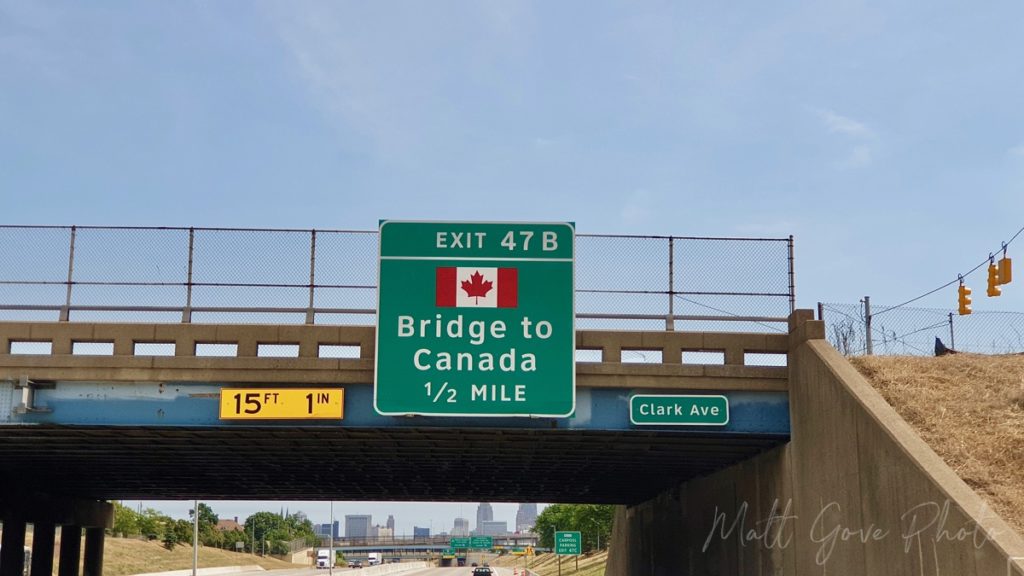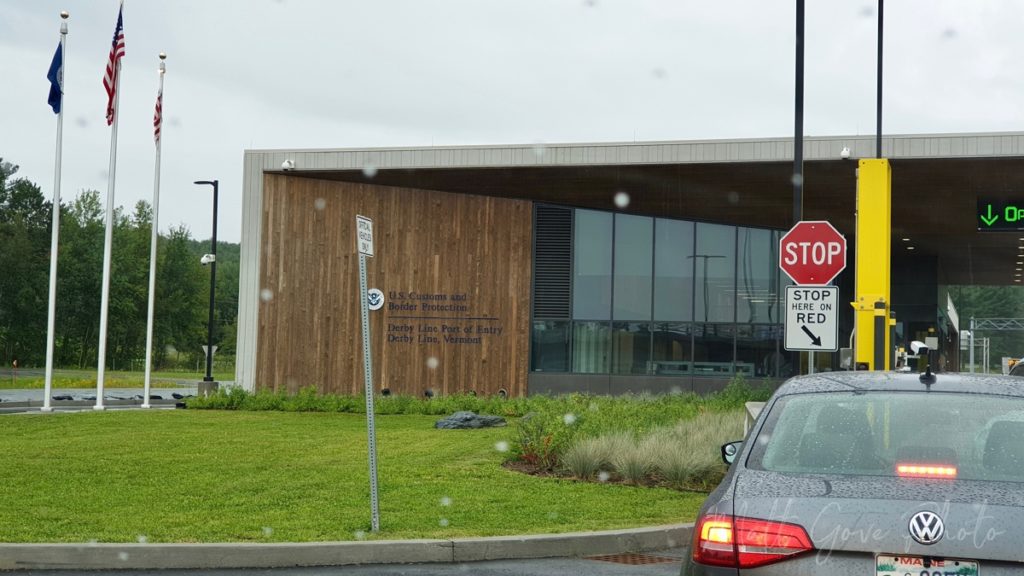In August, 2019, I made my final border crossing on an incredible road trip across Mexico, the United States, and Canada. Crossing from Stanstead, Québec to Derby Line, Vermont went so quickly and smoothly it was nothing more than an afterthought. My focus was on making it to the Haskell Free Library before it closed for the day.
Little did I know at the time, that would be my final cross-border adventure before international borders slammed shut less than six months later as the COVID-19 pandemic swept across the world. A year and a half later, some countries are cautiously beginning to reopen. As of 9 August, 2021, fully vaccinated Americans can now visit Canada for non-essential purposes.

However, if you think the border crossing will be as easy as it was in 2019, you’re in for a big surprise. There’s a lot of documentation you’ll need to be allowed into Canada. We’ll go through all of the paperwork you’ll need, as well as the rules you’ll need to follow while you’re in Canada. Make sure you have all of your documentation in order before leaving home. You will not be allowed into Canada without it.
First, Determine If You’re Eligible to Enter Canada
To save yourself a lot of headaches, the Canada Border Services Agency (CBSA) has a free online self-assessment to determine if you’re eligible to enter Canada.
We strongly recommend you use this prior to departing for the border. That way, if you’re not eligible to enter Canada, you’ll save yourself the trouble of traveling to and from the border.
Use the ArriveCAN App to Manage All of Your Documents
To make it easier to manage and submit documentation to enter Canada, the Government of Canada created ArriveCAN, a free and secure app. Submitting all of your documentation prior to arriving at the border significantly expedites the amount of time you’ll need to spend at customs.
You can download the ArriveCAN app for free from the Apple App Store or from Google Play. You can also access ArriveCAN from a web browser.

You’ll Need a Negative COVID-19 PCR Test Taken No More Than 72 Hours Prior to Your Arrival in Canada.
Regardless of your vaccination status, Canada still requires every individual that crosses its border to present a negative COVID-19 test. For Americans entering Canada, the testing requirements are simple.
- The test must be administered in the US no more than 72 hours prior to your arrival at the border.
- You must take a molecular (PCR) test. Those are the “brain tickler” tests where they swab your nose with a long Q-Tip. If you present any other type of test to the CBSA, including rapid and at-home tests, you will be denied entry into Canada.
Canada no longer requires post-arrival testing for fully vaccinated travelers. However, you may be randomly selected to complete a molecular (PCR) COVID-19 test at the border. If you’re selected, please comply with border officials. They will send you back to the US if you don’t.
Vaccinated Individuals no Longer Need to Quarantine, but You Will Need a Quarantine Plan
Fully vaccinated individuals are now exempt from Canada’s mandatory quarantine. However, the CBSA requires that you submit a quarantine plan in case you test positive for COVID-19 while you’re in Canada. Submit your quarantine plan through the ArriveCAN app prior to arriving at the border.
The easiest quarantine plan is to stay at a quarantine hotel authorized by the Government of Canada. However, doing so has some drawbacks. You will have to pay your own expenses in the event you need to quarantine. Two weeks of hotel expenses, meals, and more, can add up quick.
Your quarantine plan must show that you will:
- Remain completely isolated from all other people for 14 days or possibly longer.
- Have access to the necessities of life, including food, water, medication, and heat/air conditioning without leaving quarantine.
- Avoid contact with all others who did not travel with you.
- Have no visits from family or guests.
Anyone who is not a Canadian citizen and does not have a suitable quarantine plan will be denied entry into Canada.
If You Are Required to Quarantine, Make Daily Reports Through the ArriveCAN App
Use the ArriveCAN app to confirm that you’ve arrived at your place of quarantine. Complete daily COVID-19 symptom self-assessments until the end of your quarantine. Expect calls, emails, and visits from the Government of Canada to ensure you’re not breaking quarantine. If you’re caught breaking quarantine, you can face up to 6 months in prison and/or up to $750,000 in fines.
If you’re required to quarantine, you will be tested on the 8th day of quarantine. Should the test comes back positive, you will be required to quarantine longer.
Leaving Canada Prior to the End of Your Quarantine
You may choose to leave Canada prior to the end of your quarantine, as long as you remain aysmptomatic. Please note that you must get authorization from a quarantine officer in order to leave if you are staying at a federally designated quarantine facility. As you depart Canada, you must comply with several rules.
- Continue to quarantine yourself until your departure date
- Wear a mask when you depart Canada
- Minimize contact with the general public while you’re traveling from your quarantine facility to the border. Pay for gas at the pump and only use the drive-through when getting food.
- Comply with all rules and regulations in your destination country.
Please note that if you attempt to leave Canada while showing symptoms, you may only exit using a private vehicle through a land border. You will not be allowed on public transportation, including airplanes.
Proof of Vaccination is Required to Enter Canada
If you are not vaccinated and are not a Canadian citizen, you will not be allowed to enter Canada. It’s as simple as that. Submit your proof of vaccination through the ArriveCAN app prior to arriving at the border. If you received your vaccine in the US, use your CDC Vaccination Card as proof. Your documentation must adhere to the following rules.
- Proof of vaccination must be in English or French (or a certified translation)
- In addition to submitting proof through the ArriveCAN app, you must carry a paper or digital copy of your vaccine documentation (in English or French) when you arrive at the border.
- You must have reached full vaccination status at least 2 weeks prior to arriving in Canada.
Like the US, Canada defines fully vaccinated as 2 weeks after your second shot, or 2 weeks after your shot for a single dose vaccine. The CBSA currently accepts four vaccines, including all three that the United States has authorized for use.
- Pfizer-BioNTech
- Moderna
- AstraZeneca/COVISHIELD
- Janssen/Johnson & Johnson
If you received a vaccine that is not one of the four listed above, you are not eligible to enter Canada.
Don’t Even Think of Using Fake Vaccine Documents
The CBSA recently fined 2 Americans $20,000 each for trying to enter Canada using fake vaccine cards. The maximum penalty for submitting false vaccination information is a fine of $750,000 and 6 months in prison. Don’t even think about doing it.
Americans Showing Symptoms of Any Illness Will Be Denied Entry into Canada
It frustrates me to no avail that we have to keep saying this over and over. If you’re sick, stay home and get better. Whatever you had planned will still be there, and you’ll enjoy it much more when you’re feeling better.
Check With Local Governments in the Province or Territory You’re Visiting for any Additional Entry Restrictions
Canada implements its COVID-19 restrictions very similarly to the United States. The federal government issues general rules, including for travel and the border. But they leave figuring out details of local restrictions to provincial, territorial, and local governments.
Check with the governments of the province and city you’ll be staying in to ensure you’re complying with all entry restrictions that extend beyond what the federal government requires. The last thing you want to do is comply with all the federal restrictions only to get in trouble because you weren’t aware of a rule at the provincial or city level.
Throughout the pandemic, Ontario and Québec have both been particularly strict. On the other hand, Manitoba, Saskatchewan, and Alberta have been much more lenient.
Unvaccinated Children 12 and Under May Enter Canada with Fully Vaccinated Parents, But There’s a Catch
Unvaccinated children must quarantine for 14 days upon arrival in Canada. They must also take a molecular (PCR) test on the 8th day of quarantine. Once they’re out of quarantine, they must avoid group settings and places where people gather.
Please be aware this rule will likely change once health authorities approve vaccines for children 12 and under. Check with the Government of Canada for the latest information if you’re traveling with unvaccinated children.
You’ll Have a Larger Choice of Airports for Inbound International Flights into Canada
When the US-Canada border first closed in March, 2020, the Government of Canada directed all international flights carrying inbound passengers to land at one of four airports.
| Airport | Province |
|---|---|
| Vancouver International Airport | British Columbia |
| Toronto Pearson International Airport | Ontario |
| Calgary International Airport | Alberta |
| Montréal-Trudeau International Airport Aéroport International Montréal-Trudeau | Québec |
If you’re going to be flying into Canada, we have some good news. The federal government has expanded the list of approved airports that can accept international flights. In addition to the original four, you can now land at any of these five airports.
| Airport | Province |
|---|---|
| Halifax Stanfield International Airport | Nova Scotia |
| Québec City Jean Lesage International Airport Aéroport International Jean Lesage | Québec |
| Ottawa Macdonald-Cartier International Airport | Ontario |
| Winnipeg James Armstrong Richardson International Airport | Manitoba |
| Edmonton International Airport | Alberta |
If you’re traveling by land, all ports of entry on the US-Canada border are open. However, please advised that they may have reduced or altered their hours of operation due to the ongoing pandemic. You can get the current hours of operation on the CBSA’s website.
All of the Pre-COVID Requirements to Enter Canada are Still in Place
Finally, don’t forget that all of the requirements to enter Canada prior to the COVID-19 pandemic are still all in place. Customs will still ask you everything they asked you in 2019 and years prior. Don’t try to bring in any food, weapons, drugs, or anything else you shouldn’t be.
Returning to the United States
There are currently few restrictions on US Citizens returning to the United States. If you’re returning to the US by air, you must present a negative COVID-19 test taken within three days of your departure or proof of recovery from a COVID-19 infection within the last 90 days.
You’ll submit the test results to the airline prior to boarding the plane. Under US federal law, airlines must deny boarding to all passengers on US-bound flights who do not provide proof of a negative test or recovery, regardless of their vaccination status.
At land borders coming into the United States, you will pass through customs as you always have. US Customs and Border Protection does not require proof of negative test or vaccination for US Citizens to re-enter the United States at land ports.

References
| Reference | Source |
|---|---|
| Entry and Exit for Vaccinated Travelers | Government of Canada Travel and Tourism |
| Quarantine Requirements | Government of Canada Travel and Tourism |
| Proof of Vaccination | Government of Canada Travel and Tourism |
| Crossing the Border | Canada Border Services Agency |
| ArriveCAN App | Public Health Agency of Canada |
Conclusion
The partial reopening of the border into Canada is a beacon of hope in what’s been a brutal year and a half of closures. While we still have a long way to go in the fight against COVID-19, just remember these restrictions are only temporary.
I am certainly looking forward to when we can once again cross the border like we did in 2019. Until then, make sure you have all your required documents, be transparent and comply with border officials, and most importantly, enjoy your stay in Canada.
Top Photo: Fork in the Autoroute Just Ouside of Montréal
Les Cèdres, Québec, Canada – August, 2019